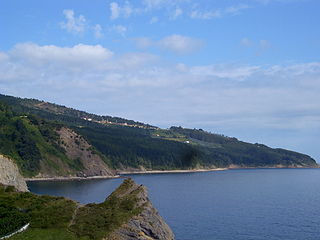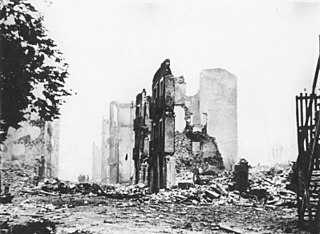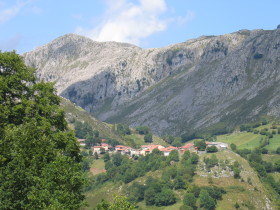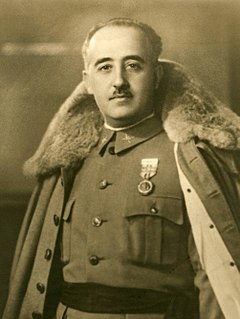 W
WThe Bombardment of Almería was a naval action which took place on 31 May 1937, during the Spanish Civil War. The Kriegsmarine bombed the city of Almería in retaliation for a Republican air attack on the German cruiser Deutschland.
 W
WThe Asturias Offensive was an offensive in Asturias during the Spanish Civil War which lasted from 1 September to 21 October 1937. 45,000 men of the Spanish Republican Army met 90,000 men of the Nationalist forces.
 W
WThe Battle of Belchite refers to a series of military operations that took place between 24 August and 7 September 1937, in and around the small town of Belchite, in Aragon during the Spanish Civil War.
 W
WThe Battle of Bilbao, part of the War in the North in the Spanish Civil War, had the Nationalist Army captured Bilbao and the rest of the Basque Country that was still being held by the Republic.
 W
WThe Battle of Brunete, fought 24 kilometres (15 mi) west of Madrid, was a Republican attempt to alleviate the pressure exerted by the Nationalists on the capital and on the north during the Spanish Civil War. Although initially successful, the Republicans were forced to retreat from Brunete and suffered devastating casualties from the battle.
 W
WThe Battle of Cape Cherchell was a naval battle between the Nationalist heavy cruiser Baleares and the Spanish Republican Navy light cruisers Libertad and Méndez Núñez in the Spanish Civil War, several miles north of the Algerian city of Cherchell. In the early morning hours of 7 September 1937, Baleares unexpectedly met a Republican convoy consisting of two merchant ships escorted by Republican cruisers and destroyers. Baleares was beaten off and badly damaged in the engagement, but the merchantmen were lost when they tried to slip away along the Algerine shoreline.
 W
WThe Battle of Santander was a battle fought in the War in the North campaign of the Spanish Civil War during the summer of 1937. Santander's fall on August 26 assured the Nationalist conquest of the province of Santander, now Cantabria. The battle devastated the Republic's "Army of the North"; 60,000 soldiers were captured by the Nationalists.
 W
WThe Biscay Campaign was an offensive of the Spanish Civil War which lasted from 31 March to 1 July 1937. 50,000 men of the Eusko Gudarostea met 65,000 men of the insurgent forces. After heavy combats the Nationalist forces with a crushing material superiority managed to occupy the city of Bilbao and the Biscay province.
 W
WThe battle of Cape Machichaco was a naval battle which took place on 5 March 1937 off Bermeo, during the Spanish Civil War, between the Spanish Nationalist heavy cruiser Canarias and four Basque Navy trawlers escorting a Republican convoy. The trawlers were protecting the transport ship Galdames, which was sailing to Bilbao with 173 passengers.
 W
WThe Bombing of Durango took place on 31 March 1937, during the Spanish Civil War. On 31 March 1937 the Nationalists started their offensive against the Republican held province of Biscay. As part of the offensive the Aviazione Legionaria and the Legion Condor bombed Durango, a town of 10,000 inhabitants that was also a key road and railway junction behind the frontline. Around 250 people are believed to have died in the bombing.
 W
WThe bombing of Guernica was an aerial bombing of the Basque town of Guernica during the Spanish Civil War. It was carried out, at the behest of Francisco Franco's rebel Nationalist faction, by its allies, the Nazi German Luftwaffe's Condor Legion and the Fascist Italian Aviazione Legionaria, under the code name 'Operation Rügen'. The operation opened the way to Franco's capture of Bilbao and his victory in northern Spain.
 W
WThe Battle of Guadalajara saw the People's Republican Army defeat Italian and Nationalist forces attempting to encircle Madrid during the Spanish Civil War. The Nationalist forces involved in the Battle of Guadalajara were primarily the Italian Corps of Volunteer Troops.
 W
WThe Battle of Jarama was an attempt by General Francisco Franco's Nationalists to dislodge the Republican lines along the river Jarama, just east of Madrid, during the Spanish Civil War. Elite Spanish Legionnaires and Moroccan Regulares from the Army of Africa forced back the Republican Army of the Centre, including the International Brigades, but after days of fierce fighting no breakthrough was achieved. Republican counterattacks along the captured ground likewise failed, resulting in heavy casualties to both sides.
 W
WThe Battle of El Mazuco was fought between 6 and 22 September 1937, between the Republican and Nationalist armies during the Spanish Civil War as a part of the War in the North campaign. The Republican defence of El Mazuco and the surrounding mountains halted the Nationalist advance into eastern Asturias, despite their forces being outnumbered sevenfold. After weeks of intense fighting over extreme terrain the defenders were eventually overwhelmed, and the Nationalists were then able to link up with their forces advancing from León, leading to the fall of Gijón and the abandonment of Asturias, the last Republican province in North-West Spain.
 W
WThe Segovia Offensive was a Republican diversionary offensive which took place between 31 May and 6 June 1937, during the Spanish Civil War. The main goal of the offensive was to occupy Segovia and divert Nationalist forces from their advance on Bilbao. After a brief initial advance the offensive failed due to Nationalist air superiority.
 W
WThe Battle of Teruel was fought in and around the city of Teruel during the Spanish Civil War between December 1937 and February 1938, during the worst Spanish winter in 20 years. The battle was one of the bloodiest actions of the war, with the city changing hands several times by first falling to the Republicans and eventually being retaken by the Nationalists. In the course of the fighting, Teruel was subjected to heavy artillery and aerial bombardment. Both sides' combattants suffered a total of over 140,000 casualties in the two-month battle.
 W
WThe Unification Decree was a political measure adopted by Francisco Franco in his capacity of Head of State of Nationalist Spain on April 19, 1937. The decree merged two existing political groupings, the Falangists and the Carlists, into a new party - the Falange Española Tradicionalista y de las Juntas de Ofensiva Nacional Sindicalista. As all other parties were declared dissolved at the same time, the FET became the only legal party in Nationalist Spain. It was defined in the decree as a link between state and society and was intended to form the basis for an eventual totalitarian regime. The head of state – Franco himself – was proclaimed party leader, to be assisted by the Junta Política and Consejo Nacional. A set of decrees which followed shortly after appointed members to the new executive.
 W
WThe War in the North was the campaign of the Spanish Civil War in which the Nationalist forces defeated and occupied the parts of northern Spain that had remained loyal to the Republican government.